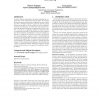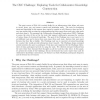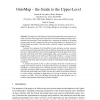2969 search results - page 85 / 594 » Ontology Learning: Where are we |
ATAL
2007
Springer
14 years 4 months ago
2007
Springer
In online, dynamic environments, the services requested by consumers may not be readily served by the providers. This requires the service consumers and providers to negotiate the...
EDUTAINMENT
2007
Springer
14 years 4 months ago
2007
Springer
Most storytelling model approaches consider stories formed by sequences of a particular type of event. These sequences are mostly constructed using the inherent temporal characteri...
EXPERT
2008
13 years 10 months ago
2008
The great success of Web 2.0 is mainly fuelled by an infrastructure that allows web users to create, share, tag, and connect content and knowledge easily. The tools for developing...
CAISE
2006
Springer
14 years 1 months ago
2006
Springer
One of the major problems in CBIR is the so-called `semantic gap': the difference between low-level features, extracted from images, and the high-level `information need'...
SEMWEB
2001
Springer
14 years 2 months ago
2001
Springer
Abstract. The upper-level ontologies are theories that capture the most common concepts, which are relevant for many of the tasks involving knowledge extraction, representation, an...



